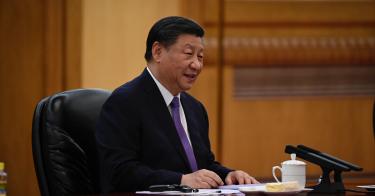Like a bad hangover, the world is quickly moving to look past Beijing’s Belt and Road initiative, which connects China to global markets.
But sobering up won’t be so easy. To construct resilient, profitable supply chains, the West will have to take China’s challenge far more seriously than Secretary of State Anthony Blinken did on his recent trip to Beijing, where he told reporters—to President Xi Jinping’s delight—that “China’s broad economic success is also in our interest.”
For starters, Washington needs to pay much more attention to the heart of Eurasia. It is time for the nations of Central Asia and the countries bordering the Caspian Sea—Kazakhstan, Kyrgyzstan, Tajikistan, Turkmenistan, Uzbekistan, Azerbaijan, and Georgia—to buck China’s malign influence and own their future.
China’s ambition to dominate global markets and supply chains, grandiosely envisioned as a “New Silk Road,” recalls the Eurasian routes that dominated global trade from Roman times to the 15th century. Then, as now, goods travel along one of three routes: the northern corridor, which winds through Russia to the West; the middle corridor, which makes its way through Central Asia, the Caspian Sea, the Caucuses and the Black Sea; and a southern corridor, which crosses the Indo-Pacific to Africa and then moves upward through the Middle East and the Mediterranean.
>>> Normal No More: It’s Time To Review China’s Trade Status
But after many years of press releases and unrealized promises, Beijing’s belts and roads mostly look like bridges to nowhere.
Russia’s war on Ukraine has triggered a flurry of sanctions against Moscow and has hamstrung the northern corridor. Nations in the middle corridor, the countries of Central Asia and the Caucuses, have been reluctant to sign big ticket infrastructure deals with China after watching Beijing saddle countries like Pakistan and Sri Lanka with massive amounts of debt that have stymied economic growth and led to bankruptcy.
As for the southern corridor, China simply doesn’t have enough strength to dominate the Indo-Pacific, the Middle East, and the Mediterranean—all key links in one of the world’s most vital maritime corridors.
Boxed in, Beijing is only becoming more belligerent. But China’s aggression is a sign of weakness, not strength.
No part of the world needs to think longer and harder about that reality than the nations of Central Asia. Indeed, rather than being a truck stop on China’s superhighway, the “middle corridor” countries can still play a critical role in global supply chains by connecting Central Asia and the Caucasus to the vibrant, free, and open global economy.
Now is precisely the time for the region to choose its own fate. All of these nations once languished in the post-Soviet space, and many are still over-influenced by the dictates of Moscow, but Russia today can hardly take care of itself, much less its neighbors.
Iran, too, was once a great regional power with major influence that has since declined. Mired in its own problems and controversies, contemporary Tehran hardly has time to exert itself in the region.
The U.S., Europe, the Middle East, Africa, and the powers of the Indo-Pacific like Japan, South Korea, Taiwan, and India would all benefit from linking to the energy, transport, potential manufacturing, and natural resources that Central Asia could bring to the global market. But to counter Beijing, the West and its allies will have to stop kowtowing to China and start concentrating their efforts.
>>> Chinese Exports Controls Overdue: Implementation and Oversight Is Key
Below are two messages that Blinken’s state department should home in on and start promoting in the region:
First and foremost, Central Asian powers must stand up for themselves. Although many countries participate in regional forums—from the Organization of Turkic States to the Shanghai Cooperation Organization, or even America’s C5+1 diplomatic platform—none of these forums are owned by the stakeholders themselves. It doesn’t need to be this way. The presidents of Kazakhstan, Kyrgyzstan, Tajikistan, Turkmenistan, Uzbekistan, Azerbaijan and Georgia are all going to be at the September UN General Assembly meeting in New York. President Biden should meet with them and encourage these six key countries to get together and establish their own independent organization to coordinate policies and jointly develop the middle corridor.
Secondly, Eurasia must innovate. There is no substitute for foreign-direct investment from the private sector that is open, transparent, follows responsible commercial practices, and respects the rule of law. To attract such financing, Eurasian countries should band together and follow standard internal commercial practices establishing a commercial fund (that attracts private sector investments) and management team that can direct resources to key regional infrastructure projects. In this pursuit, the Central European Threes Seas Initiative offers a good potential model.
Rather than pretending that Biden can simultaneously manage China, buy-off Iran, and defeat Russia all by himself, Washington should set its sights on working constructively with partner nations, particularly in Eurasia, to support peace and open exchange. Doing so will limit the deleterious effects of great power competition and ensure a brighter future for America and the region.
This piece originally appeared in 1945




